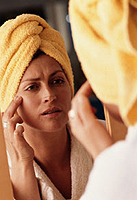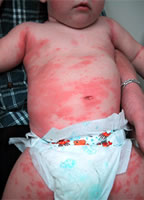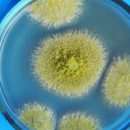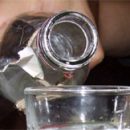What is urticaria? What kind of urticaria? What are the causes of urticaria? How treatment is carried out? Answers to these questions you will find in the article.
Content
Urticaria, urticaria
Urtica (urtica, lat. - The nettle) is the general name of a group of diseases that are characterized by the occurrence of red-colored blisters on the skin, pale with pressure, clearly degraded, towering over the skin surface, the size of several millimeters to several centimeters. A peculiarity of urticaria is the rapid appearance of blisters and their quick disappearance within 24 hours. Angioedema swelling or swelling of quinque described in 1882. Quinke, often combined with a wretched or develops independently. Manifests as an asymmetric skin edema of any area.
It is believed that from 15 to 25% of the population, at least once in their lives, transfer the urticaria, and in a quarter of these cases, the urticaria takes a chronic character.
Modern international classification of urticaria involves its division on «Spontaneous», which occurs without a certain direct impact, physical, arising after various physical impacts, and the so-called individual types of urtic. In turn, spontaneous urticaria is divided into acute (up to 6 weeks) and chronic (more than 6 weeks). Physical urticarps include dermographic (which is literally translated from Greek as «Drawing on the skin», Since it appears after applying light scratches on the skin), as well as a slow motion of pressure from pressure (blisters appear after 3-8 hours after squeezing the skin, for example, when standing or seat), cold urticaria (cold air / water / wind), thermal Urticaria (local thermal impact), «solar» Ultravica (ultraviolet radiation and / or visible light) and vibration (vibratory impact, for example, working with a jackhammer).

TO «Individual» The types of wretchedness include cholinergic (caused by a physical or emotional voltage, leading to a small increase in body temperature), adrenergic (caused by the separation of adrenaline, for example, in stress), contact (for example, allergic contact urticaria, it can be caused by skin with a substance, to which the patient has a strong allergy, it can be dust, animal wool, plants pollen or metals, such as nickel). The same group includes the so-called aquagenic urticule. It occurs after entering the skin of water and is explained by the fact that water is a solvent for an allergen, which is generated directly in the skin of such people. Other diseases such as pigment urticaria (mastocytosis) and family cold wretchedness belong to the wretchedness only historically and have a completely different nature.
However, the most frequent types of gapivnits are spontaneous (acute and chronic), dermographic (especially in young entities) and contact. Much less often meets the cholinergic. But if everything is clear with the contact urticaria (allergies now do not surprise anyone), then everything is not so simple with spontaneous and dermographic, not to mention other types of urticaria. Historically, the idea is that the urbin is a purely allergic disease. However, in reality, the allergy is so rare causes chronic urticaria (according to different estimates, from 0.5 to 1% of cases) that allergy surveys are not recommended as a standard procedure. On the other hand, allergies are quite often the cause of the urban of acute and swelling of the quinque - in the form of a reaction to medical preparations (for example, vitamins and antibiotics) and insect bites. In some cases, the cause of acute urticaria can be the true nutritional allergy, however, in such cases, the diagnosis is usually no doubt, since the reaction develops immediately after the substance falls into the body and begins with the place where this substance fell - in food allergies there are lips swelling, Language and sky, and with intramuscular injections itching and redness begins with the field of injection.
True allergic response on immediate type is developing very quickly - from a few seconds to 15 minutes (hence its name). Such a reaction is dangerous in that it can directly move into anaphylactic shock - severe condition, often leading to death. On the other hand, aspirin and the like drugs (the so-called group of NSAIDs - non-steroidal anti-inflammatory drugs) often cause a pseudo-allergic reaction, which can also develop quite quickly (although it is usually much later than the true allergies) and accompanied by a very dangerous state - Pickling in the area of the larynx with difficulty breathing, which requires immediate hospitalization in the intensive care unit.
Causes of urticaria
But back to the urban. Because of what a spontaneous urticary develops, by and large, still unclear anyone. However, there are so-called diseases associated with urban. In particular, it is long known that the urticaria is often developing in the pathology of the gastrointestinal tract (actually, the first description of the uterus belongs to Hippocratic, and he observed it just in a patient with the pathology of the digestive system). In this regard, the intestinal diseases are considered (in particular, dysbacteriosis), esophagus, stomach and duodenum (ulcers, gastritis, duodenites), diseases of the liver and biliary tract (hepatitis, cholecystitis). Sometimes the cause of urticaria is parasites (glides invasion). There is also evidence that the urticaria is often found in tumors, thyroid diseases and so-called systemic diseases of the connective tissue (for example, systemic red lupus).
 Therefore, to seek the cause of the urticaria - the lesson is a long and painstaking, often the reason to establish and fails, and the urticaria is then called «idiopathic», that is, with an unidentified cause. Although the sake of justice should be said that, when identifying a disease associated with the Harpivnye, the urban will still be called «idiopathic», Since there is no concept in modern nomenclature, for example, «Hardwriter caused by exacerbation of chronic gastritis». After all, despite the fact that the urticaria and inflammation in the stomach simultaneously meet very often, the mechanisms for which it can occur is still unknown, and therefore the very presence of such interconnection is recognized not by all scientists.
Therefore, to seek the cause of the urticaria - the lesson is a long and painstaking, often the reason to establish and fails, and the urticaria is then called «idiopathic», that is, with an unidentified cause. Although the sake of justice should be said that, when identifying a disease associated with the Harpivnye, the urban will still be called «idiopathic», Since there is no concept in modern nomenclature, for example, «Hardwriter caused by exacerbation of chronic gastritis». After all, despite the fact that the urticaria and inflammation in the stomach simultaneously meet very often, the mechanisms for which it can occur is still unknown, and therefore the very presence of such interconnection is recognized not by all scientists.
In 1998 g. Bruno published a work in which he showed great importance in the occurrence of the dermographic urticaria of the gastroesophageal reflux - throwing the acidic content of the stomach in the esophagus due to the insufficiently developed muscular wall of the lower part of the esophagus. Normally, the contents of the stomach is acidic due to the formation of hydrochloric acid that promotes digestion. People with the insufficient development of the muscular wall of the esophagus may occur in the back of the acidic content of the stomach in the esophagus. This leads to inflammation of the mucous membrane of the esophagus, which can cause pain and heartburn, and may pass asymptomatic. G. Bruno determined that most patients with dermographic urticaries have exactly such a disease.
Currently, there is an active study, how much this and other similar problems may be the cause of other types of urticaria. In particular, it is established how great the role «Helicobacter Pilori» (H. Pylori) - bacteria causing gastritis and ulcers. It is not clear that it may be exactly the cause of urticissal - bacterium or a stomach disease that it causes. Some researchers persistently continue to look for special forms of allergies. So far, really not too successfully.
How treatment is carried out
Since the cause of the disease remains a mystery, antihistamines (the formation of the blister and the appearance of the skin, the very formation of the blisters and the appearance of the skin ferrifers are caused by. It is recommended to use the latest generation preparations that have a long action and rarely cause side effects. These include, in particular, Cetirizine, Levocetyriazine, Ebastin, Loratadine, Disloratadine (trade names, respectively, Zirtek, Xizal, Kestin, Claritin, Erius) and others. Them is enough to apply once a day. And if there is insufficient effectiveness, it is recommended to increase the dose of up to 2 and even 4 tablets per day. In severe disease, steroid hormones can be assigned a short course, but only under the control of the doctor. Long-term use of hormones is not recommended due to pronounced side effects. When identifying the concomitant disease, it is necessary to deal with it in parallel. Often, the urticaria after that passes, whatever opponents of such theory.









